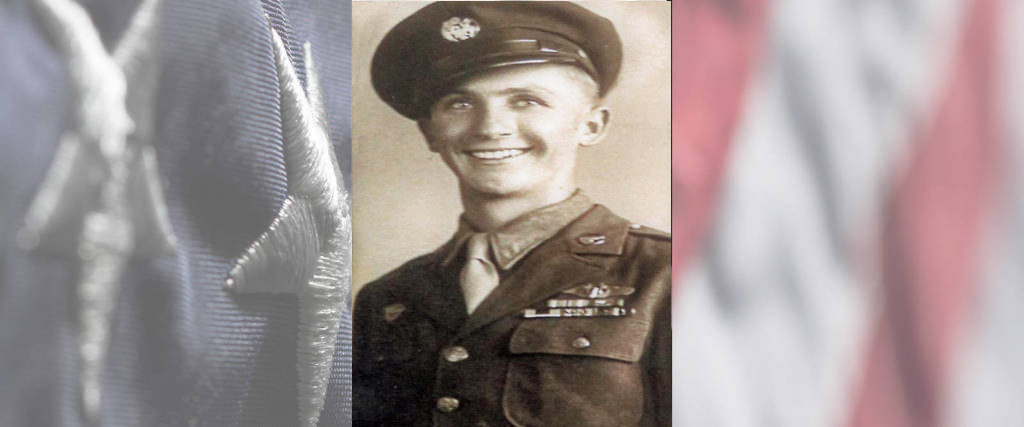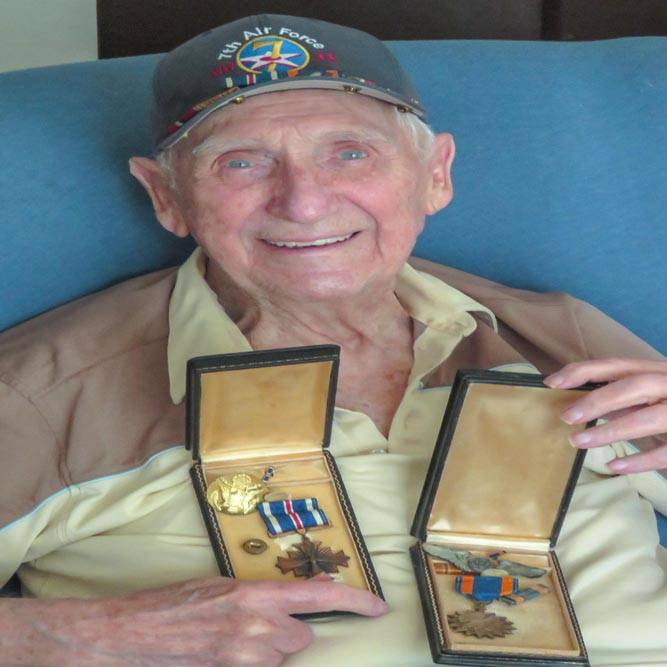U.S. Army Air Corps WWII Marengo, IL Flight date: 07/11/18
By Carla Khan, Honor Flight Chicago Veteran Interviews Volunteer
E. John Gebel spent the first years of his life in New Haven, CT. His parents’ house was between two local grade schools, so they decided to have him attend each school every other year. As a result, he grew up to be a very easy going individual who easily made many friends. In a way, this fun-loving background also turned out to be somewhat of a handicap. By the time he was ready for high school, his family had moved to New York City, where he quickly discovered the many attractions the city offered such as ice skating, roller skating, and big bands. More than once he skipped school and had to hide from the truancy patrol. During one of his escapades, he did see the King and Queen of England and he is still proud of that!
In spite of his many adventures, Elmer graduated from high school in 1940 and found himself a job at American Mutual Insurance Company where, of course, he made friends. The father of one of his friends happened to work for the Sperry Gyroscope Company and introduced him to navigation equipment. Elmer, with his talent for mechanics, was fascinated from the first moment he saw the electronics, and it later influenced his military service.
On January 16, 1943, he received his draft notice and reported to Fort Dix Army Base, NJ. Instead of being immersed in a military routine, Elmer and his fellow draftees were quarantined for 30 days because of an outbreak of scarlet fever. Soon afterwards, the new soldiers were put on a military train to Miami, FL for Basic and Technical Training. They learned how to march and also learned how to spot stingrays in the river from their sergeant; for many of the recruits it was the first time in their lives they had to obey someone who was of Hispanic origin. However, they liked their sergeant so much that at the end of the training, they took up a collection and bought him a watch.
Elmer did well and was asked to take the exam for officers training. Unfortunately, because he was very nervous, he scored one point short of that required for officers training. He also tested for a pilot slot, but at the time, the Army Air Corps had enough pilots. Elmer, who had a very high score in the mechanical section, was sent to the Gulfport, MS Naval Base where he would spend the next 9 months learning all about being an aircraft mechanic. Upon finishing, he was asked if he wanted to stay on as an instructor, but he chose to move on instead.
His next assignment was Gunnery School in Texas; he absolutely loved the challenge of hitting targets. The soldiers were put on a truck holding their shotguns and told to hit a target while they were moving or they remained stationary and told to hit a moving target. Next, Elmer went to the Ford Willow Run B-24 plant in Ypsilanti, MI where the B-24 Liberator bombers were manufactured. Over a period of two months, at Flight Engineer’s School, he learned all about engine repair, aircraft maintenance, including emergency repairs and jungle training. Upon completion, it was off to Tucson, AZ where the final crew for “his” bomber was assembled: a pilot, co-pilot, flight engineer, and six gunners.
Elmer was in charge of the first-aid kit (learning how to give morphine shots had been part of the training), and he assisted the pilots during take-off and landing by calling out the altitude and airspeed and alerting them to possible obstacles. In Lincoln, NE, a temporary runway was so narrow that the outsides of the plane’s tires were slightly off the concrete on both sides. When the plane was being parked, it was Elmer’s job to stick his head out of the top turret to check for the right parking spot. The gunners in the bay of the aircraft also received their on-the-job training from Elmer.
Elmer recalls on one training mission that, unknown to the crew, the instructor had replaced some good fuses with bad ones for the final flight-check. Elmer, while double checking his aircraft just prior to the flight, replaced the bad fuses. It was the first time the instructor had a flight pass with 100% and the crew thanked Elmer. They knew they were going to be safe with him. Elmer reached the rank of Sergeant while stationed in Boise, ID.
Finally the aircraft and crew were ready to participate in the Far East war theater. They departed but discovered, within an hour, that the 650-gallon fuel tank that they carried inside the aircraft was leaking. Elmer found himself walking through inches of gasoline of the floor. He requested that they return to base, but unfortunately, the aircraft was too heavy for the runway. The fuel had also leaked outside the plane and had turned the normally grey colored fuselage a bright green. They landed anyway. Later that evening, with nothing better to do on the base, the crew fired their pistols for fun. Elmer took the blame for the entire crew for this poor decision, was reprimanded and told to “get the @#$! out of here the first thing the next morning.”
The next day, they headed west with Johnston Island as their destination. Since the 2,400 mile trip was out of range for the B-24, the pilot had to cut back on power during parts of the flight, stopping in Hawaii to refuel. They reached their destination without any problems and after a day or two, continued on to the Eniwetok Atoll in the Marshall Islands. They stayed there for quite a while and Elmer got to take his first swim in the Pacific. At the same time, the crew was being prepared for combat flight. As part of the preparation, they were issued little flags with “Return for Reward” written on them in Chinese and several other languages in case they were shot down and captured. They practiced jungle survival skills including emergency aircraft repairs, and finally they practiced bombing accuracy, using the wreckages of sunken ships. Now the crew of the B-24 was prepared and Elmer started out on the first mission of forty total combat missions in the South Pacific theater.
Their mission objective was to eliminate enemy bases and prepare the sites for the Marines. The first mission was to the Palau Islands where they destroyed runways. Usually, they were very lucky but on occasion they flew into fierce enemy defense. Twice their plane was on fire when they returned; another time an enemy shell went straight through the fuselage and missed Elmer only by a foot. Because one of the islands near the base where they were stationed had an active volcano, return navigation was made easy, heading towards the plume of smoke on the horizon.
Then, one day, when the troops were enjoying a break by watching an outdoor movie, they suddenly heard all the ships in the harbor begin to fire their guns randomly. At first, they didn’t know what was going on but soon the word spread, “The War Was Over!” Elmer received special orders to report to Manila then flew home as a passenger in a converted C-54 routed through Hawaii and California. He was discharged at Fort Dix, NJ Army Base where it all began.
He returned to his parents’ home in Manhattan and found himself a maintenance job at JC Penney. For fun and something to do, Elmer joined a Swedish Folk Dancing group. There, he noticed Rose, a young lady whom he invited to dance. One thing led to another and soon they were engaged. They were married for 54 years and have five children. They moved to the midwest because of Elmer’s job with JC Penney where he worked until his retirement. Decades after the war ended, Elmer met some Philippine immigrants from the same towns he helped to liberate. They thanked him profusely and all enjoyed a late celebratory dinner together.
Thank you for your Service, Elmer. Welcome home and enjoy your well-deserved Honor Flight!




